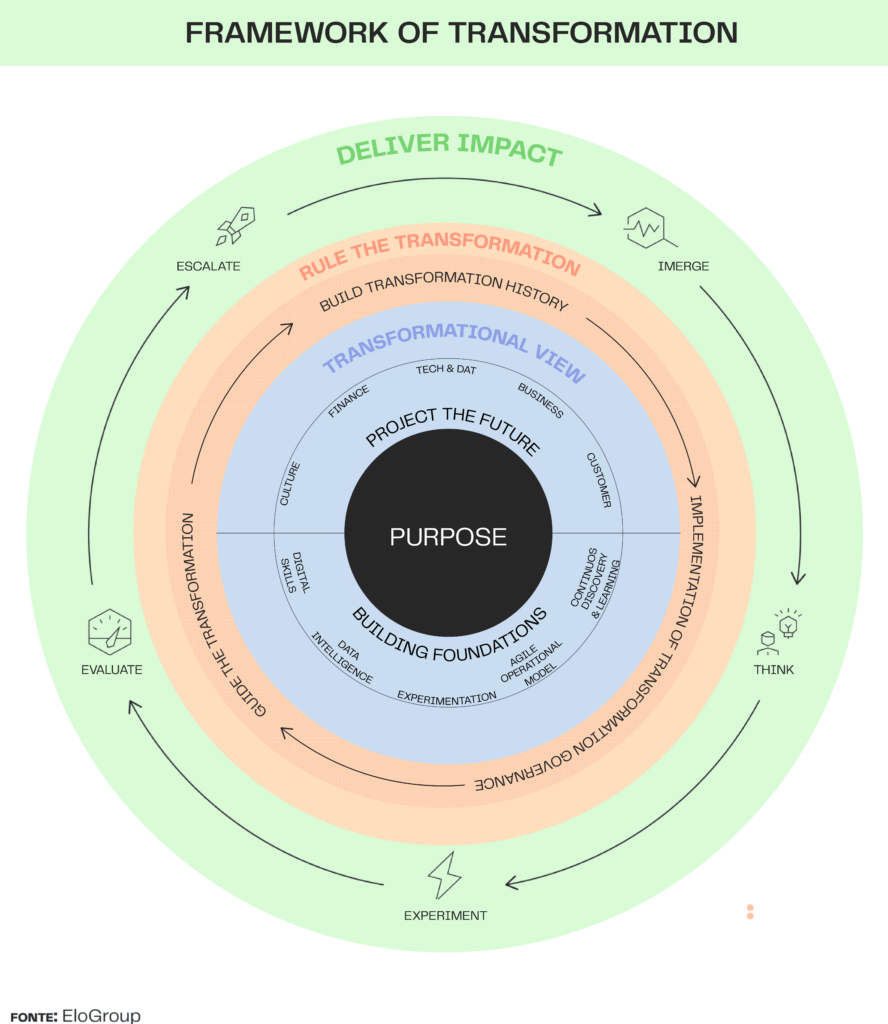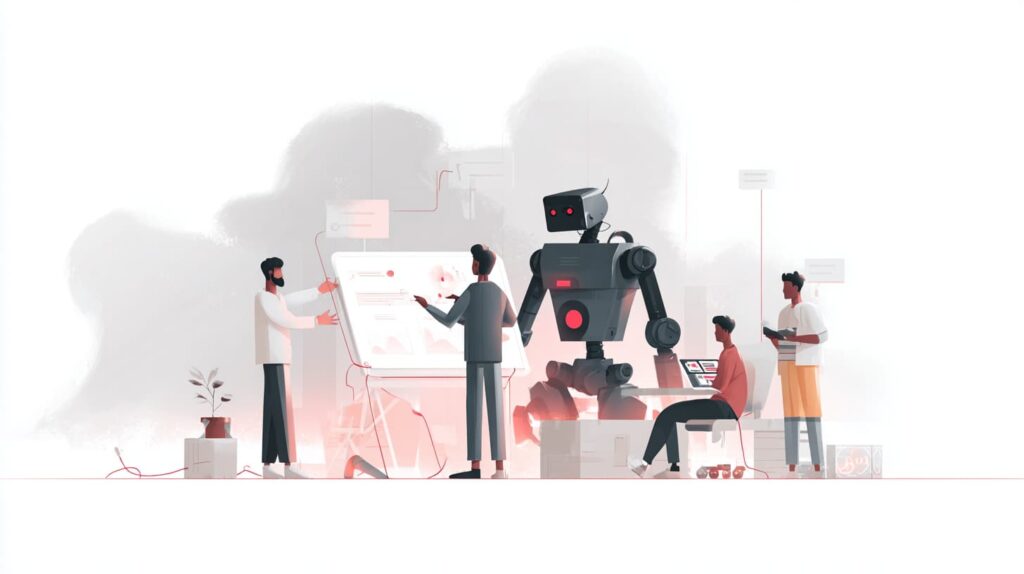By EloInsights, in collaboration with Marcos Navarini
- The transformation of an organization by adopting a culture that is driven by change includes processes, people and technologies.
- Aiming the innovation, there are major battles to be fought, from projecting the future to building solid foundations to support the new models.
- In this series, we will start by talking about the first of these battles, indicating approaches and tools to facilitate projecting the future.
This is the first in a series of four articles on the Great Battles of Transformation that will be published on EloInsights.
In 10 steps towards a successful transformation, we look at how creating purpose and firm foundations are key to making change a continuous cycle within organizations. Constantly transforming a business involves several factors linked to processes, people and technologies.
In this series of articles, we have discussed the adoption of a “driven by change” culture, dividing the transformational journey into four major “battles”: designing the future, governing change, delivering and measuring impact and building foundations for continuous transformation. In this text, we will deal with the first one.
The following framework was built from multiple points of view and from the experience of EloGroup consultants. It shows the connections and interactions between the stages of transformation and highlights the most important capabilities and elements in each of them.
Purpose is the central element, guiding the planning and execution of all the processes. To explain it, we will describe each of the battles, including mistakes that can be made along the way. We also point out approaches, methodologies and tools to get round them.

1st Battle of Transformation: Projecting the future
Every change has impact on the organization – positively or negatively – and, because of that, even when it is on a smaller scale, it needs to be aligned with a projection of the future and a purpose that also includes a macro strategy, its main goals and priority levers. All these aspects make up the transformational vision.
The first challenge is to carry out a diagnosis of current needs, with an eye on opportunities for improvement and keeping competitiveness in the market. Only an in-depth analysis of the organizational context, its pains and obstacles, will provide an understanding of the problems that need to be solved and the results that must be achieved to meet the strategic aims. The purpose guides and influences the entire process, which takes shape by considering various perspectives and a broad study of the market and the external context.
A simple way of connecting the purpose of the transformation to the strategic context of the organization can be to get in close contact with key executives, listening to their wishes and demands, allowing priorities to be defined and which Transformation Imperatives are most relevant: extracting value by doing more without wasting resources; expanding value by acquiring new customers or by exploiting other channels or operational levers; creating new value by developing innovative products and services; or redefining value by targeting new markets and business models.
In this first stage, some mistakes can cloud the transformative vision, jeopardizing the fluidity of the journey due to a lack of understanding of the problems to be solved and the main levers to be activated. We have listed some of them below:
Mistake 1: Not thinking big enough
Ideally, every investigation should get to the root of the problems. And although it is not an effortless process, it is crucial to gain a deep understanding and build a transformative vision. A diagnosis based on known pains or the interests of a part of stakeholders is not enough. It is necessary to carry out an assessment combining internal beliefs with external inspiration, such as practices adopted by competing companies or related sectors. In other words, mechanisms need to be put in place to avoid a shallow diagnosis:
Applying problem-solving techniques, such as root cause trees or the HMW (How Might We) questioning technique and immersing yourself in the context are the basis of a problem investigation. It is essential to understand who the actors are, what the stages of this process are, what pains exist, how often they appear and what the degree of criticality is, among many other points. The big point here: it is more important to focus on the problem than the solution.
Formal governance structures with transversal coordination – such as the Transformation Office (TO), for example – allow you to think big. Reinforcing or creating rites and execution tracks with the use of tools to control and check the execution of initiatives and the allocation of resources are elements that help keep cohesion with the macro strategy of the transformation.
It is necessary to apply various lenses to the problems to look at the projection of the future from different perspectives, always from a viewpoint that integrates Technology, Analytics and Management (TAM). We can think of an equation in which T*A*M is multiplied. If any of the factors are missing, the result will be zero. It is by integrating the three pillars simultaneously that the organization will be able to make the most of its potential. In this construction we can frame questions in the following dimensions:
- Customers: what generates value; what is the experience like; what are the needs and desires; what processes affect or are affected by customers?
- Business: how is value generated; what are the company’s tactical and strategic goals from the general context of the sector; how does the competition work?
- Technology and data: which technologies enable change? which of them act as magnifying lenses for improvements and opportunities – considering the current architecture and infrastructure and those that need to be built?
- Culture: what is the profile of the people; how do they work and how is management done; is there readiness and motivation for transformation?
- Financial: with which financial results and goals does this transformation connect; which levers enhance value; how will the funding (allocation of resources) for the transformation be made viable?
Mistake 2: Being overly ambitious
Getting the company’s delivery capacity wrong frustrates expectations, wastes resources and causes misalignment. From the outset, it is essential to examine constraints and barriers – including behavioral and political ones – as well as defining individual and collective objectives. The following checklist is a good guide:
- Identify the level of stakeholder buy-in both among executives and in managerial and operational positions; who will support and encourage the process?
- Consider the current mindset and organizational culture: will it be a complete paradigm shift or an increase in practices and structures that are already being used or implemented?
- Looking at the past, how has the company dealt with similar situations?
- What resources are available, from a human and financial point of view?
- What is the focus and goal of the stakeholders, beyond the context of the sector or the market in general?
- What are the deliverables and results expected in the short, medium and long term?
Mistake 3: Ignoring best practice
Most of a company’s problems have already been solved elsewhere. To avoid trying to reinvent the wheel and, by that, waste time and energy on existing solutions, it is essential to look inwards, to similar scenarios and even to innovative sectors:
Exploring good internal practices, applied in other sectors of the organization, can be a relevant source of inspiration. Especially in large companies, it is common for there not to be good visibility of actions taken by other teams. Knowing how problems are being solved, such as the use of enabling technologies, for example, makes it possible to identify previously unknown opportunities and even utilize capabilities already present in the company.
Examining the movement of start-ups and competitors and following innovations injects creativity into problem-solving, even if they are far removed from the company’s current reality. It is interesting to consult reports, trends, surveys and rankings, such as the 100 Startups to Watch. The competition can inspire insights and it is worth checking out different sectors that may face similar challenges, as well as looking at the international market and the activities of large corporations.
Understanding the expectations of customers, both external and internal, is a way of critically considering how to raise the bar. Will adopting innovative technology really be innovative and take the organization to the next level?
Mistake 4: Getting stuck to the present and to established paradigms
Traditional thinking often gets in the way of changing processes, practices and using modern technologies. There is an aversion to risk and the complexity that adapting to new formats requires. Transformation must combine analytical thinking with a creative and innovative future-back approach.
Starting with the future, projecting into the long term the scenario of the context being transformed, visualizing the best way this process could be carried out and, from there, unfolding solutions to reach that level. This approach is profoundly different from the one that starts from the current state to identify problems and solve them; it allows us to break established paradigms and understand how trends are going to change the rules of the game.
Connecting to the ecosystem, assessing how other organizations can dynamically link up with yours to solve this problem. Partnerships are a way of expanding and complementing organizations’ capabilities, such as technological skills, access to markets or service or product offerings. Naturally, these decisions must be based on a broader ecosystem positioning strategy, but this lens should be applied whenever possible.
The principles of Effectuation, a logic of thought structured from cognitive scientist Saras Sarasvathy’s studies with entrepreneurs, inspire a way of controlling an inherently unpredictable future.
Experts in entrepreneurship use a set of techniques as a basis for decision-making. They start with what they can control: who I am, what I know, who I know. One of the principles is not to get stuck in the worst-case scenarios thinking about “what if”, but to use unforeseen events and surprises in the journey as possible clues to bet on new paths.
In the next article, we will tackle the second great battle of transformation: how to govern change.
MARCOS NAVARINI é consultor sênior e líder do Digital Lab da EloGroup.











